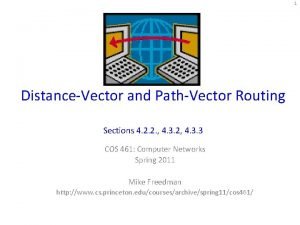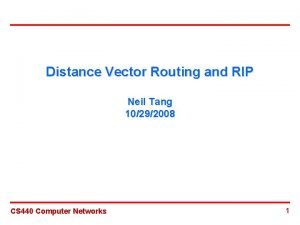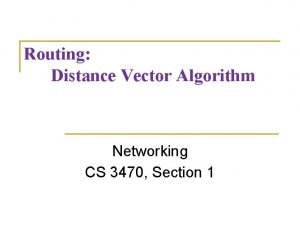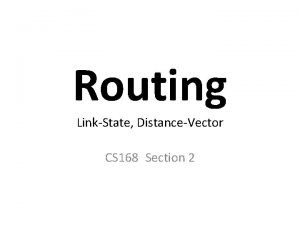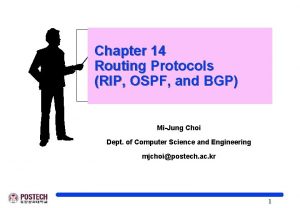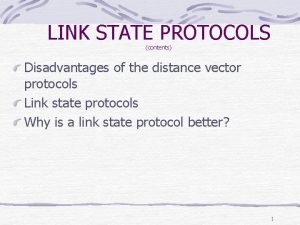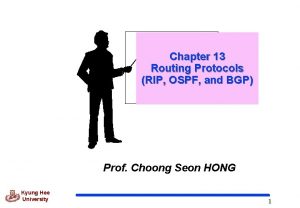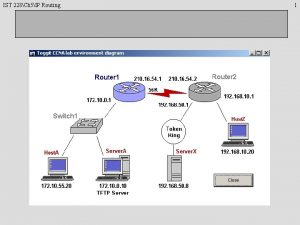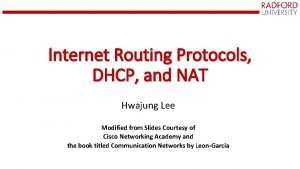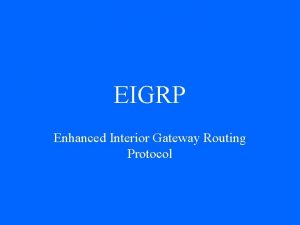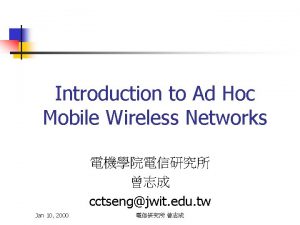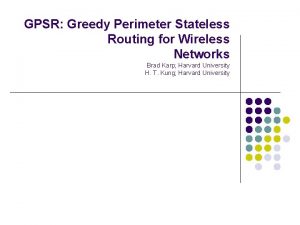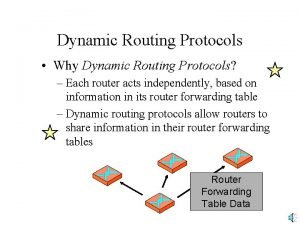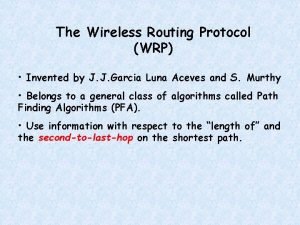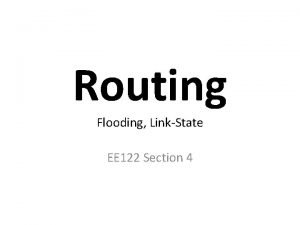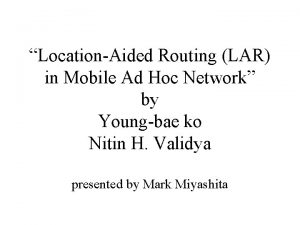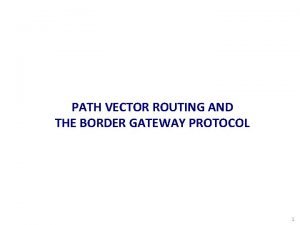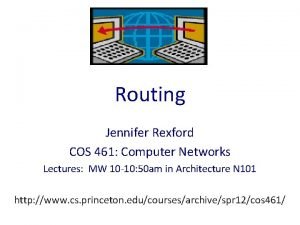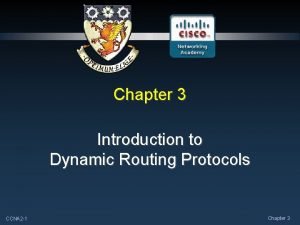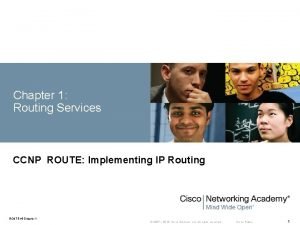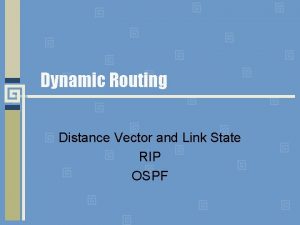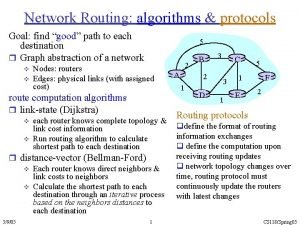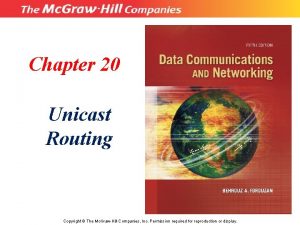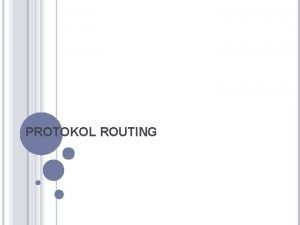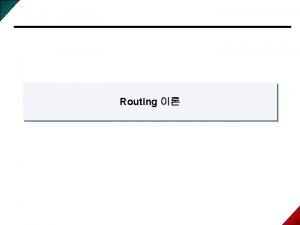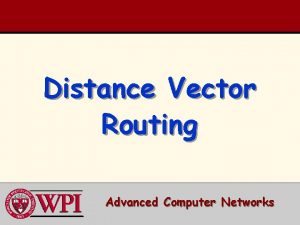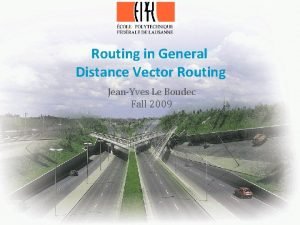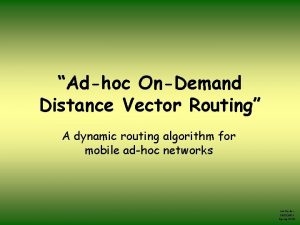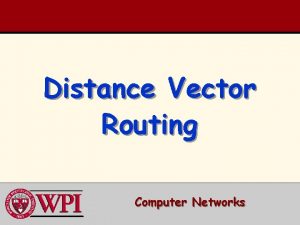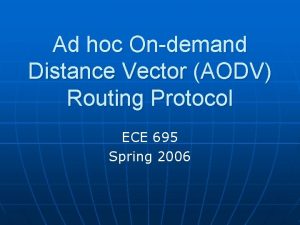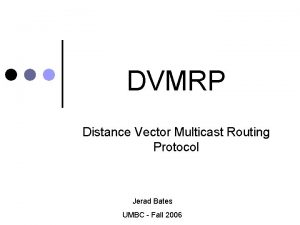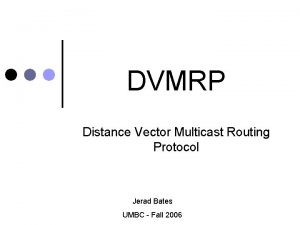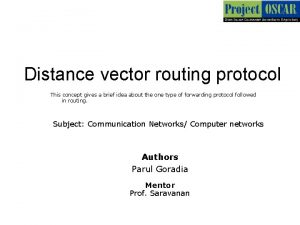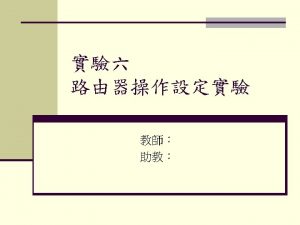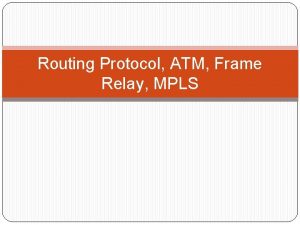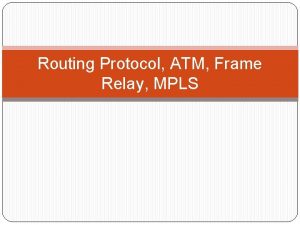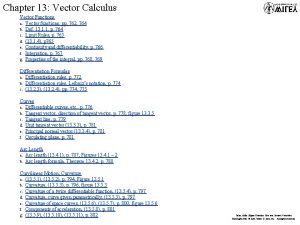Routing with a Distance Vector Protocol in an































- Slides: 31

Routing with a Distance Vector Protocol in an Enterprise Network Introducing Routing and Switching in the Enterprise – Chapter 5 ITE I Chapter 6 © 2006 Cisco Systems, Inc. All rights reserved. Cisco Public 1

Objectives § Compare and contrast a flat network and a hierarchical routed topology. § Configure a network using RIP. § Describe and plan a network using EIGRP. § Design and configure a network using EIGRP. ITE 1 Chapter 6 © 2006 Cisco Systems, Inc. All rights reserved. Cisco Public 2

Compare and Contrast a Flat Network and a Hierarchical Routed Topology § Enterprise hierarchy § Combination of LAN and WAN technologies § DMZ ITE 1 Chapter 6 © 2006 Cisco Systems, Inc. All rights reserved. Cisco Public 3

Compare and Contrast a Flat Network and a Hierarchical Routed Topology § Traffic control § Redundant links § Qo. S § Packet filtering ITE 1 Chapter 6 © 2006 Cisco Systems, Inc. All rights reserved. Cisco Public 4

Compare and Contrast a Flat Network and a Hierarchical Routed Topology § Star and extended star topologies § Mesh topologies Partial mesh Full mesh ITE 1 Chapter 6 © 2006 Cisco Systems, Inc. All rights reserved. Cisco Public 5

Compare and Contrast a Flat Network and a Hierarchical Routed Topology § Building the routing table Exit interface Next hop Administrative distance ITE 1 Chapter 6 © 2006 Cisco Systems, Inc. All rights reserved. Cisco Public 6

Compare and Contrast a Flat Network and a Hierarchical Routed Topology § Directly connected routes § Static routes § Dynamic routes ITE 1 Chapter 6 © 2006 Cisco Systems, Inc. All rights reserved. Cisco Public 7

Compare and Contrast a Flat Network and a Hierarchical Routed Topology § Advantages of static routing Stub networks Security Lower overhead ITE 1 Chapter 6 © 2006 Cisco Systems, Inc. All rights reserved. Cisco Public 8

Compare and Contrast a Flat Network and a Hierarchical Routed Topology § Static route configuration ITE 1 Chapter 6 © 2006 Cisco Systems, Inc. All rights reserved. Cisco Public 9

Compare and Contrast a Flat Network and a Hierarchical Routed Topology § Summary static routes § Floating static routes ITE 1 Chapter 6 © 2006 Cisco Systems, Inc. All rights reserved. Cisco Public 10

Compare and Contrast a Flat Network and a Hierarchical Routed Topology § Default routes § Gateway of Last Resort ITE 1 Chapter 6 © 2006 Cisco Systems, Inc. All rights reserved. Cisco Public 11

Routing Using the RIP Protocol § Characteristics of distance vector protocols § Hop count metric § Advantages and disadvantages ITE 1 Chapter 6 © 2006 Cisco Systems, Inc. All rights reserved. Cisco Public 12

Routing Using the RIP Protocol § Characteristics of RIPv 1 Automatically summarizes at classful boundary Broadcasts routing updates every 30 seconds ITE 1 Chapter 6 © 2006 Cisco Systems, Inc. All rights reserved. Cisco Public 13

Routing Using the RIP Protocol § Characteristics of RIPv 2 Classless Multicasts updates Provides authentication mechanism ITE 1 Chapter 6 © 2006 Cisco Systems, Inc. All rights reserved. Cisco Public 14

Routing Using the RIP Protocol § RIPv 2 configuration Basic commands Authentication Default route redistribution ITE 1 Chapter 6 © 2006 Cisco Systems, Inc. All rights reserved. Cisco Public 15

Routing Using the RIP Protocol Problems with RIP and their solutions: Problem Solution Discontiguous subnets No auto-summary Unnecessary traffic Passive-interface Routing loops Poisoned reverse, split horizon, holddown timer, triggered updates ITE 1 Chapter 6 © 2006 Cisco Systems, Inc. All rights reserved. Cisco Public 16

Routing Using the RIP Protocol § Verification commands Troubleshooting commands Ping for end-to-end connectivity ITE 1 Chapter 6 © 2006 Cisco Systems, Inc. All rights reserved. Cisco Public 17

Describe and Plan a Network Using EIGRP § Disadvantages of distance vector routing protocols ITE 1 Chapter 6 © 2006 Cisco Systems, Inc. All rights reserved. Cisco Public 18

Describe and Plan a Network Using EIGRP § Compare EIGRP and RIP ITE 1 Chapter 6 © 2006 Cisco Systems, Inc. All rights reserved. Cisco Public 19

Describe and Plan a Network Using EIGRP § Characteristics of EIGRP Composite metric Guaranteed loop-free operation Bounded updates Hello packets ITE 1 Chapter 6 © 2006 Cisco Systems, Inc. All rights reserved. Cisco Public 20

Describe and Plan a Network Using EIGRP § Neighbor table § Topology table § Routing table ITE 1 Chapter 6 © 2006 Cisco Systems, Inc. All rights reserved. Cisco Public 21

Describe and Plan a Network Using EIGRP § Successors and feasible successors § External routes ITE 1 Chapter 6 © 2006 Cisco Systems, Inc. All rights reserved. Cisco Public 22

Describe and Plan a Network Using EIGRP § EIGRP neighbors and adjacencies § Hello protocol § EIGRP packet types ITE 1 Chapter 6 © 2006 Cisco Systems, Inc. All rights reserved. Cisco Public 23

Describe and Plan a Network Using EIGRP § RTP: Reliable Transport Protocol § PDM: Protocol Dependent Module ITE 1 Chapter 6 © 2006 Cisco Systems, Inc. All rights reserved. Cisco Public 24

Describe and Plan a Network Using EIGRP § EIGRP metrics and convergence § K values § Feasible and reported distance ITE 1 Chapter 6 © 2006 Cisco Systems, Inc. All rights reserved. Cisco Public 25

Design and Configure a Network Using EIGRP § Basic EIGRP configuration § Wildcard masks § Logging neighbor changes § Bandwidth § Load balancing ITE 1 Chapter 6 © 2006 Cisco Systems, Inc. All rights reserved. Cisco Public 26

Design and Configure a Network Using EIGRP § EIGRP summarization § Parent and child routes § Null 0 interface § Manual summarization ITE 1 Chapter 6 © 2006 Cisco Systems, Inc. All rights reserved. Cisco Public 27

Design and Configure a Network Using EIGRP § Verification commands § Troubleshooting commands ITE 1 Chapter 6 © 2006 Cisco Systems, Inc. All rights reserved. Cisco Public 28

Design and Configure a Network Using EIGRP § EIGRP issues and limitations ITE 1 Chapter 6 © 2006 Cisco Systems, Inc. All rights reserved. Cisco Public 29

Summary § Enterprise networks are hierarchical § Networks use static and dynamic routing to move information § Dynamic routing protocols are classified as either distance vector or link state § RIP is a distance vector routing protocol § EIGRP is a Cisco proprietary distance vector routing protocol with many advanced features § EIGRP works best if its default features are modified to suit the routing situation ITE 1 Chapter 6 © 2006 Cisco Systems, Inc. All rights reserved. Cisco Public 30

ITE 1 Chapter 6 © 2006 Cisco Systems, Inc. All rights reserved. Cisco Public 31
 Distance vector
Distance vector Distance vector
Distance vector Vector algorithm
Vector algorithm Distance vector routing
Distance vector routing Distance-vector routing
Distance-vector routing Advantages of link state routing vs distance vector
Advantages of link state routing vs distance vector Distance vector routing
Distance vector routing معنیr.i.p
معنیr.i.p Hydrologic routing and hydraulic routing
Hydrologic routing and hydraulic routing Clock skew
Clock skew Goodrich method is used for
Goodrich method is used for Mark tinka
Mark tinka Dhcp routing protocol
Dhcp routing protocol Enhanced interior gateway routing protocol
Enhanced interior gateway routing protocol Tora routing protocol
Tora routing protocol Gpsr routing protocol
Gpsr routing protocol Ospf routing protocol
Ospf routing protocol Wrp protocol
Wrp protocol Link state routing protocol
Link state routing protocol Lar routing protocol
Lar routing protocol Ospfv
Ospfv Bgp path vector
Bgp path vector Path vector routing
Path vector routing Routing protocols administrative distance
Routing protocols administrative distance Bgp administrative distance
Bgp administrative distance Vector unitario
Vector unitario Vector resolution examples
Vector resolution examples Define the term position vector
Define the term position vector Directed line segment
Directed line segment Distance vector vs link state
Distance vector vs link state Distance vector algorithm
Distance vector algorithm Distance vector
Distance vector
